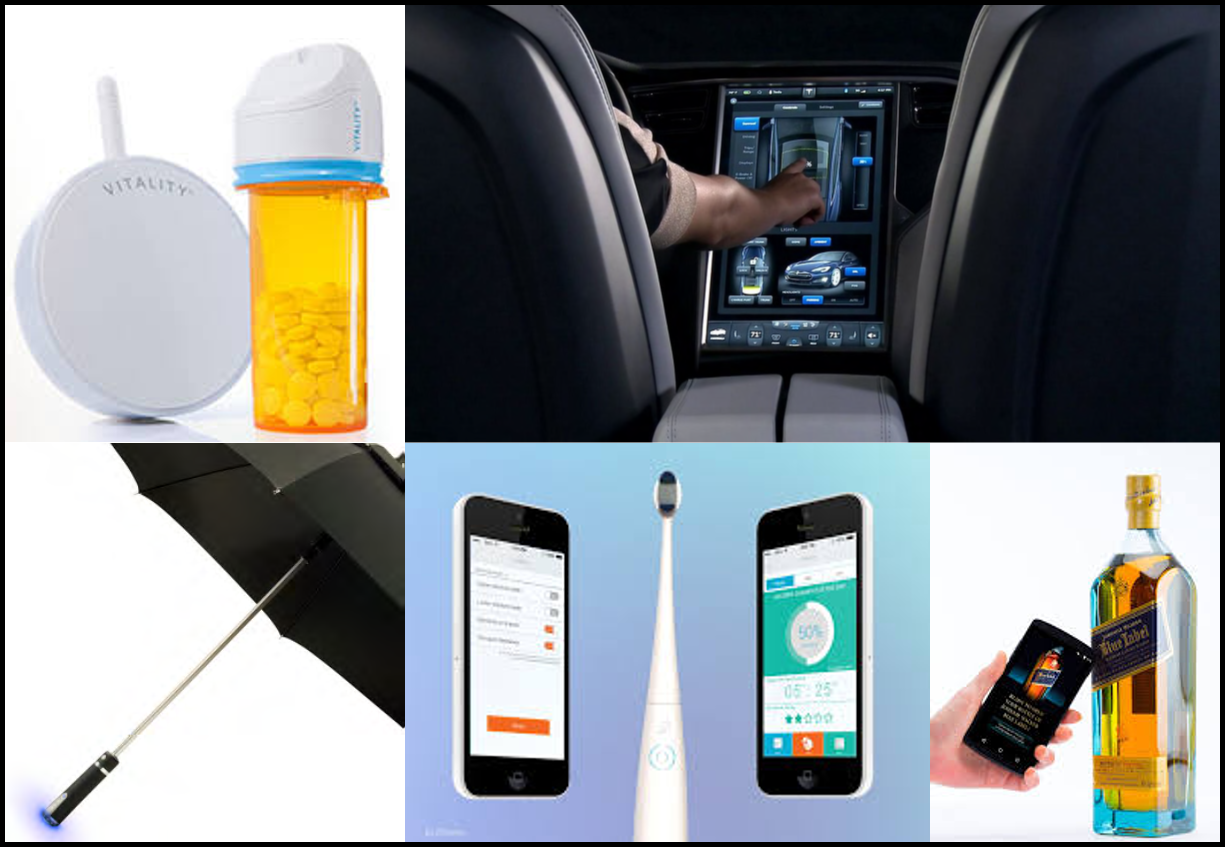Much attention has been given to the recent growth in the marketing technology sector – as we’ve seen firsthand, the number of solutions in the marketplace keeps multiplying and venture investment continues to pour in. There are some good reasons for this exuberance, and it’s becoming clearer that we can add one more to the list… and it could be one of the biggest yet. 
When you think of how cutting edge marketing technology reaches its audience, you might consider emergent consumer touch-points such as smartphones, tablets, or maybe even smart TVs. The proliferation of these devices has contributed to an exciting new era of marketing technology. So what’s the next major addition to the device list? How about a bottle of Johnnie Walker? Or maybe it’ll be a toothbrush. Most likely, it will be both… plus nearly every other ordinary physical object we interact with on a daily basis.
The number and types of ‘smart’ devices connected to the internet are changing rapidly – just look at the rise of smartphones and tablets over the last five years. Yet, to date most of these new touchpoints still function like traditional PCs, just… more portable. Another great wave in marketing technology is on the horizon, and it will take place in the physical world as “smart” objects begin to permeate the real-life objects around us.
Soon, your medication bottle will alert you when you deviate off schedule and it will automatically send a refill request to your pharmacist at the appropriate time. Your car will fix itself while it sits in your garage at night. Your toothbrush will monitor your brushing, provide customized feedback and automatically send reports to your dentist. Your umbrella will alert you before leaving the house if rain is forecasted. In several cases, these types of things already exist – and marketing technology leaders are clearly recognizing the magnitude of the opportunity. Just take Adobe’s emphasis on their emerging IoT marketing solutions at their Summit in March as an example.
So why is this happening now? To answer that, it might be helpful to take a step back and consider a few key technology building blocks now in place that make it all possible:
Rise of smart phones
We are all glued to our smart phones and, because of this, they are quickly becoming the central portal for all things digital in our lives. As a16z’s Benedict Evans recently put it, the smartphone’s dominance is so complete that it’s useful to think of it as the sun; the object around which everything else in the (technology) planetary system revolves. Having one central portal like this in the palm of our hand enables us to track, interact with, and respond to countless smart objects in our day to day lives.
Falling costs of connective technology
In a large portion of the U.S. and other developed nations, the infrastructure is now in place so that the web is widespread and cost-effective enough to allow for the rapid scaling of two-way information exchange. In addition, the miniaturization of object connectivity technology like NFC, Wi-Fi chips, RFID and printable sensor tags has started to pass key tipping points in terms of cost – as EVRYTHNG’s Andy Hobsbawm noted in his recent Q&A with Scott Brinker.
Source: Reproduced from “Practical Electronics for Inventors”, Paul Scherz and Simon Monk.
Real time technology (RTT)
RTT refers to technology that allows a user (or device) to receive and react to data during the actual time that a physical process occurs, known as real time. Real time is measured in milliseconds or microseconds. In the context of IoT, think of it as the ability for many objects in a network or system to instantaneously and automatically exchange information, make decisions and act on those decisions based on their surroundings.
Cloud-based delivery model
Cloud computing has had a profound impact on the scalability, speed-to-market and economic viability of new technology. Through the cloud, IoT technology providers can now host vast amounts of data collected from scattered devices in a more flexible and cost effective manner. In addition, providers can “ship” software upgrades or tweaks immediately to the entire field or individually selected devices. In essence, the cloud delivery model allows the technology provider to “talk” with any number of devices, whether they be toothbrushes or medicine bottles. Without recent advancements in cloud computing, it would not be possible to fix software issues or react to changing conditions once devices were out in the physical world. Cloud technology also allows users to maintain continuity across devices and objects.
Image Credit: IBM Cloud
These new technologies form the infrastructure which opens up a whole new world of possibilities for digital concepts applied in the physical form. From a marketing and consumer experience perspective, companies will be presented with a vast new realm of possibilities to interact with their target consumers in a highly relevant manner. Rising adoption of IoT technology will have profound implications for marketing paradigms – the following describes just a few:
Everything is a Touchpoint
IoT is creating an explosion of new opportunities to engage with, and satisfy customers. Consider the emerging concept of the physical web. As Google characterizes its open source project: “People should be able to walk up to any smart device – a vending machine, a poster, a toy, a bus stop, a rental car – and not have to download an app first. Everything should be just a tap away.” Based on physical beacon technology (an interesting subset of IoT), you may soon be able to stand on any city block, look at your smartphone, and see everything from discounts at nearby stores to the next stop on the bus line – or you may be able to extend the time on your parking meter – all on one interface based on your exact location. This type of context rich platform introduces countless opportunities for creative marketing technologists.
Everything-as-a-Service (XaaS): Revolutionizing customer experiences
The fusion of product and service is coming. As Jonathan Cagan and Craig M.Vogel explain in their book, Creating Breakthrough Products, “product systems and service systems can no longer be discussed as separate. The opportunity for innovation is in creating new businesses where products, services and interfaces are seen as interconnected parts of the value and profit in any new idea. Every product is connected to a service system, and every system relies on products that deliver value to consumers.” In a short period of time, it will be standard to expect our thermostats to continually look for ways to save us money on our energy bill. We might expect our washing machines to provide personalized, value added recommendations. Imagine if your washing machine, after recognizing certain washing trends, displayed a message: “I recommend [x] brand stain remover for your white clothes – press the order button and it will arrive in 2 days.” That’s powerful marketing because it’s useful.
An entirely new category of data
To date, nearly all of the behavioral / psychographic data collected by marketers has been based on digital actions. But as physical objects start interacting with us on a daily basis, companies will benefit from an entirely new class of data – a context-rich type of data that can provide insights like never before. Continuous feedback loops from the physical world could empower products to better serve users and marketers to more effectively induce consumers.
Cross-dimension tracking and attribution
In order to extract the maximum value out of IoT technology, marketers will seek to seamlessly track and reach individuals back and forth between the 2 dimensional (digital) and the 3 dimensional (physical) realms. In theory, this means collecting data from one environment (e.g. your incessant social media posts about finding a good pair of shoes) and using it to more effectively retarget you toward a particular product (e.g. a digital billboard outside a running shop recommending a particular shoe as you walk by. Or, in the more near term, an advertisement strategically placed in your physical web portal on your mobile phone for a shoe store around the block). This is much easier said than done – from both a technical and privacy standpoint – but this is where we are headed.
Brought together, all of these pieces – made possible by IoT technology – have the potential to propel the marketing industry further toward its ultimate goal: smarter, more relevant, more frequent interaction with the right people throughout the customer lifecycle. A new generation of marketing technology solutions will be critical to marketers as they explore exactly how to capitalize on a world full of “smart” objects. There are certainly still hurdles to overcome (privacy and security to name a few), just as there are with any game changing technology in its nascence, but the potential impact of IoT on the marketing technology industry can’t be ignored. Whether it plays out in the form of an explosion or it manifests itself more gradually, one thing seems clear – the interconnectivity of the internet that gave rise to a new “golden” era of marketing technology is pouring over into the physical world.



